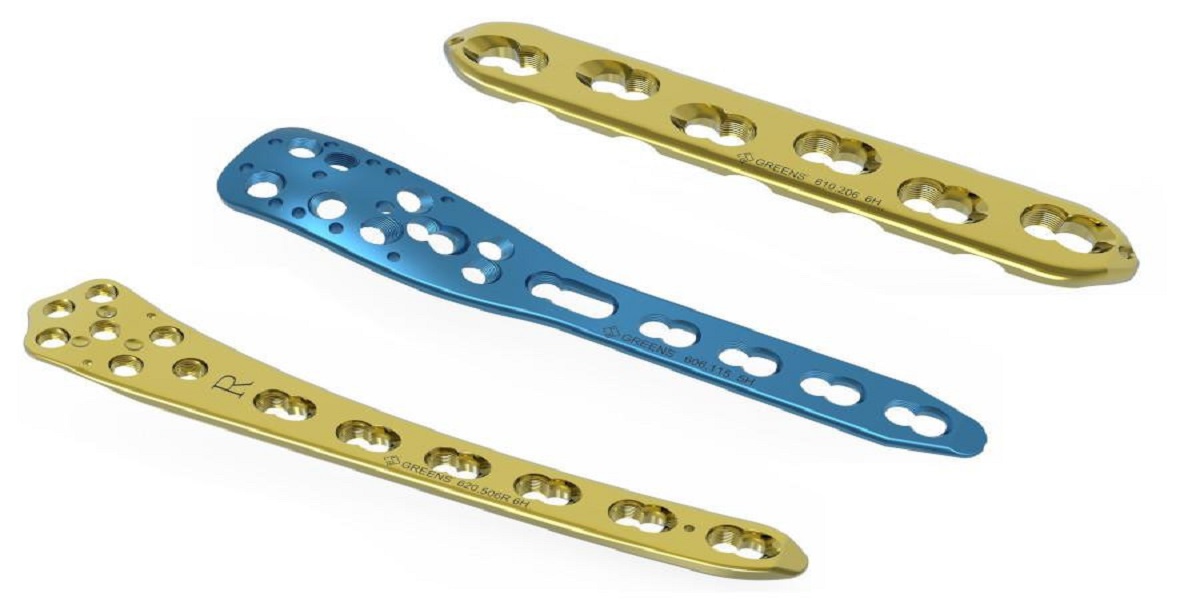
Use of Locking Plates in Treatment of Osteoporotic Fractures
Osteoporosis causes bones to become weak and brittle, so brittle that a fall or even mild stresses can cause a fracture. Osteoporosis-related fractures most commonly occur in the hip, wrist, or spine. Bone is living tissue that is constantly being broken down and replaced. Osteoporosis occurs when the creation of new bone doesn't keep up with the loss of the old bone. Osteoporosis affects all races. There typically are no symptoms in the early stages. But once bones have been weakened, one might have signs and symptoms that include: Back pain, caused by a fractured vertebra, loss of height, and stooped posture. Locking Plates are applied to decrease the gap between bone at the fracture site and provide rigid fixation. These plates are especially helpful for patients with osteoporosis and fractures with numerous segments.
These fractures are common in older adults and can often be treated without surgery. However, for some patients with more severe fractures, surgery may be required. An efficient treatment option for these patients is the use of these plates. They are metal plates that are inserted into the bone to hold the fracture in place. They are becoming increasingly popular as a treatment for osteoporotic fractures, as they provide stability and help to reduce the risk of further fracture.
WHAT ARE LOCKING PLATES AND HOW DO THEY WORK?
Reduced bone quality, common in older people, increases the technical difficulty and complications of operative treatment of fractures. The goal of the surgery is to optimize joint alignment, preserve blood supply to aid healing, and provide stability to allow fast mobilization. Plates from a good orthopedic implants manufacturer are especially helpful for patients with osteoporosis and fractures with various segments. Here, screws become one with the plate decreasing the possibility of hardware failure. Stability and pullout strength are determined by the sum of all locked screws. When screws are locked into fixed angles the broken bones stay closer together on both ends of the break, elevating the likelihood of quality healing. These plates also decrease motion between the plate, screws, and bone. Direct plate-to-bone compression is not necessary, better preserving the blood supply to the bone. The plate-screw assembly distributes stress along the entire length, making plates better suited for osteoporotic bones.
The use of plates in the treatment of osteoporotic fractures has become increasingly popular in recent years. This type of surgery involves the placement of a metal plate over the break, which is then secured with screws. The advantage of this approach is that it provides stability to the bone while it heals, preventing the need for a cast or other immobilization device. In addition, it is less invasive than other types of surgery and can be performed on an outpatient basis. As a result, it is an attractive option for older patients who are at risk for complications from more traditional surgeries. While the use of locking plates is generally safe and effective, there are some risks associated with the procedure. These include infection, nerve damage, and blood loss. However, these risks are typically low and can be minimized with proper care and follow-up. Overall, the use of these plates is a safe and effective option for treating osteoporotic fractures.
WHAT ARE THE BENEFITS OF USING THESE PLATES TO TREAT OSTEOPOROTIC FRACTURES?
There are several benefits to a locking system: A locking plate does not have to precisely contact the underlying bone in all areas. When these screws are tightened, they lock to the threaded screw holes, stabilizing the segments without pulling the bone to the plate. Locking screws make it impossible for screw insertion to alter the reduction. Non-locking systems require a proper adaptation of the plate to the underlying bones. Without this close contact, tightening of the screws will pull the bone segments toward the plate, resulting in loss of reduction and possibly the occlusal relationship.
Treatment of osteoporotic fractures has classically been performed with either intramedullary nails or plate and screw constructs. These devices also allow for a more anatomic reduction of the fracture, which can help to improve patient outcomes. In addition, plates can be easier to remove than traditional plate and screw constructs, if revision surgery is necessary. As a result, these plates have become a preferred choice for the treatment of fractures.
CONCLUSION
Thus, this is a metal plate that has screws sticking out of it. The screws can be turned to tighten the plate against the bone. This helps hold the fracture in place so it can heal. Plates from an efficient orthopedic implant manufacturer are widely used to treat osteoporotic fractures, which are fractures that occur in bones that have been weakened by osteoporosis. These fractures most often occur in the hip, spine, and wrist. These plates may be used when other treatments, such as casting or bracing, are not possible or have failed. They offer several advantages over other treatments for osteoporotic fractures. They are more stable than casting or bracing.
Leave a Comment
© Copyright © 2024 gwsmed.com | GWS Surgicals LLP. All rights reserved.
| |




Comment (0)
No Comments Yet. Be the first one.